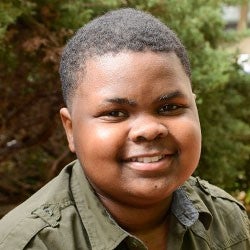Burkitt's Lymphoma
When Devin Cherry went from an active 9-year-old to a lethargic one with no appetite, his mother, Viette Smith, knew something was amiss. However, getting a diagnosis proved difficult. Smith took Devin to numerous doctors and emergency rooms, but no one could find a problem. Finally, Smith made an appointment with an allergist, who didn’t even perform an exam before sighting Devin’s problem. “He had a mass in his neck that had gotten so large she could see it when he opened his mouth,” Smith said. “Thankfully, she didn’t say anything to alarm Devin. She just told me that I needed to go straight to emergency room at Children’s of Alabama.” While Viette was relieved to finally know what was wrong, the reality of the situation soon set in when initial scans and test suggested Devin might have cancer. “The doctors were running so many tests to ensure an accurate diagnosis, and they knew it would be either non-Hodgkin’s lymphoma or Hodgkin’s lymphoma,” Smith said. “A biopsy confirmed it was Burkitt’s lymphoma, a form of non-Hodgkin’s.” A final diagnosis also meant big decisions for Smith. Should she and Devin stay in Birmingham at Children’s or go home to Washington, D.C., where they had family and a larger support system. “Devin was so comfortable at Children’s that I decided I didn’t want to take him away from that,” Smith said. “That was the right decision because from the doctors to the janitorial staff, everything there was amazing. The care I saw him already getting was a plus.” Devin’s doctors crafted a treatment plan that originally included Devin undergoing outpatient chemotherapy, but due to problems he was experiencing with his port, Devin was admitted to the hospital again. For four months, he stayed at Children’s receiving chemo before scans revealed the mass had shrunk significantly. “We finally got to go home, but it didn’t last very long,” Viette said. “A scheduled checkup two months later showed that the cancer had come back in his lungs. So he was admitted and started treatment all over again.” After the relapse, doctors suggested two high doses of chemotherapy and a bone marrow transplant. Doctors harvested Devin’s own stem cells for the transplant. “He had to endure a lot, but he did well,” Viette said. “The transplant went great.” Post-transplant, Devin, now 15, has returned to school and resumed his favorite activities. He’s even playing his favorite sport, baseball, again. “I have so much appreciation for Children’s of Alabama,” Smith said. “It was a hard road we had to go down with Devin, but I can’t say enough about how caring and supportive everyone was at Children’s, both of Devin and me. The doctors took care of us, answered every single question I had and treated Devin as if he was their own.”







